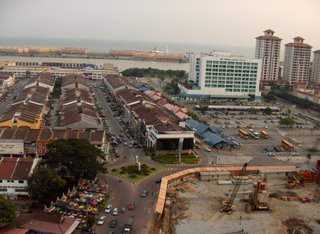




These views of the historic town of Melaka were taken on the evening of 24Aug2006 from the 16th floor of Hotel Equatorial. On the right is St Paul’ Hill, & towards the left is Jalan Parameswara where the hotel is located. The greater part of the bay area is land reclaimed from the sea which is part of the Straits of Malacca. Coincidentally, Dataran Mahkota, with the round building compassed by the construction site towards the right was advertised in the Saturday’s Straits Times as an investment opportunity.
Imagine, half a millennium and more or so, out in the sea, this would had been a very busy port. From the late 14th century with the founding of the Melaka Sultanate and over next three centuries, Melaka the main port of call in South East Asia.
Atop St Paul’s hill is a statue of St Francis Xavier, the Jesuit priest whose memory is also enshrined in the park in Oita Japan. (St Francis Xavier & land of the Christian Daimyo) .Francis Xavier came with the Portuguese conquistadors with the mission of spreading the good news to the non-believers living in Cathay and Nippon. He stayed at the St Paul’s Cathedral atop the hill, where the hill is now named after. On his onward journey to the far east, Francis Xavier also mentioned in his notes that his ship stationed at the mouth of the Kallang River.. A copy of his notes could be seem at the Asian Civilization Museum, Elizabeth Place.
Before the Portuguese came Melaka, or Malacca till her name was officially changed, was the premier port of call in the Malay Archipelago and it was also where the Melaka sultanate began some 600 or more years ago. The Portuguese records had it that - ‘Parameswara a prince from the Sumatra royal house was fleeing from the Javanese masters. The ruler of Tumasik, Gamarajah welcome him. He was more interested in piracy than in trade. However he later murdered Gamarajah and took over the throne. The murdered ruler was a relative of the Thai overlord, who was angered and sought revenge on Parameswara. He escaped overland and founded another great city – Melaka’. (Source: the defunct - Singapore History Museum @ Riverside Point)
How closely is history intertwined and what it was eons ago maketh what we are today – as the saying goes 无古不成今 – without the past we would not have been what we are now. Tumasik, name of ancient Singapore before Sang Nila Utama set foot on this island and founded the Lion City, was the heart of the Singapura Sultanate 700years ago. It was a busy trading port with traders coming from Sung China, Arabia and from the regions.
As it is where a replica of the palace of the Melaka Sultanate is build on the foothill of the of St Paul’s hill near the mouth of the Melaka River, the palace of the Singapura Sultanate was located at Fort Canning or Bukit Larangan – the Forbidden Hill - near the mouth of the Singapore River. Singapura as a trading post faded into history after the murder of Gamarajah and the baton was passed on to Melaka.
The Melaka Sultanate was at its zenith in the early years of the 15th century. In 1405, the Ming Admiral Cheng Ho on its maiden maritime expedition – 郑和下西洋 - call at this port. There is a temple and a well named after Admiral Cheng Ho in the city. The expeditions also left behind a rich and unique legacy – the Peranakan, the Straits born culture. The peranakan cooking, the nyona delicatessen is very much a part of our daily food menu, and it has truly spiced up our lives.
Melaka fell to the Portuguese in 1511, and subsequently she was under the rule of the Dutch and then the British. When Raffles landed in Singapore in 1819, and rejuvenated the island that was in slumber for 600 years, the earliest batch of migrants that came to this island was the Peranakan’s from Melaka.
-//-


